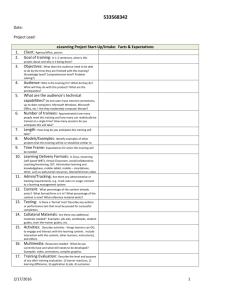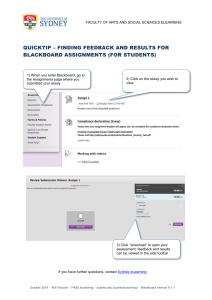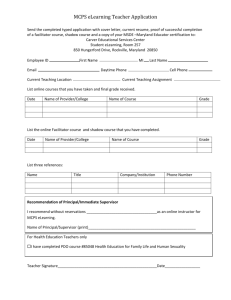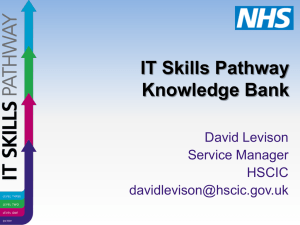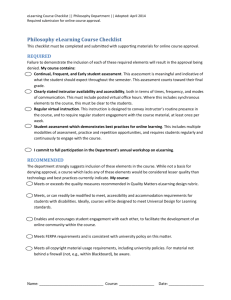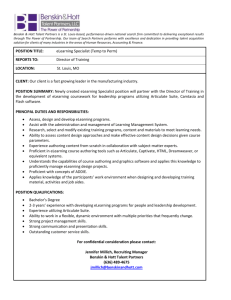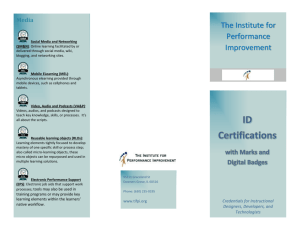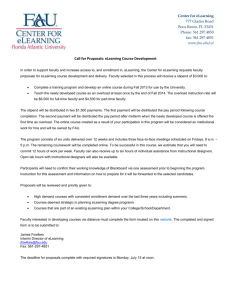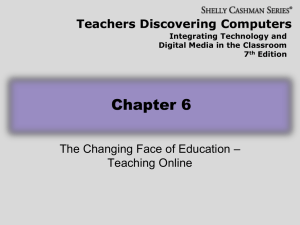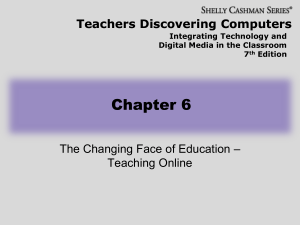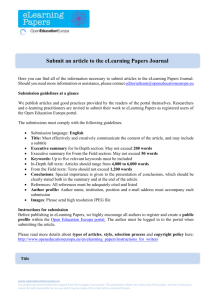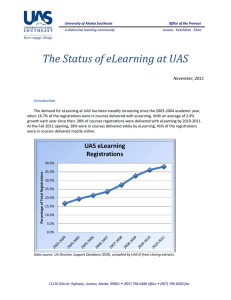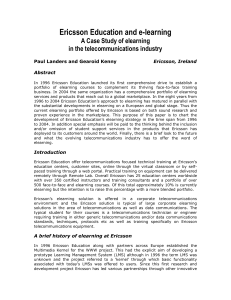Mandatory training information
advertisement
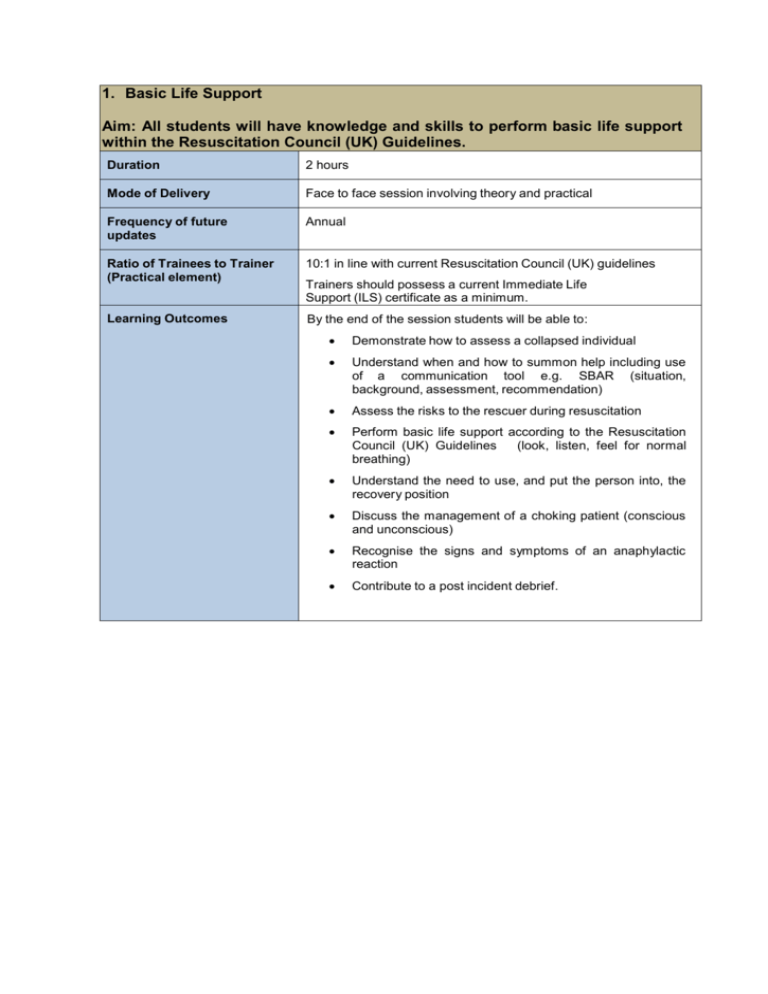
1. Basic Life Support Aim: All students will have knowledge and skills to perform basic life support within the Resuscitation Council (UK) Guidelines. Duration 2 hours Mode of Delivery Face to face session involving theory and practical Frequency of future updates Annual Ratio of Trainees to Trainer (Practical element) 10:1 in line with current Resuscitation Council (UK) guidelines Learning Outcomes By the end of the session students will be able to: Trainers should possess a current Immediate Life Support (ILS) certificate as a minimum. Demonstrate how to assess a collapsed individual Understand when and how to summon help including use of a communication tool e.g. SBAR (situation, background, assessment, recommendation) Assess the risks to the rescuer during resuscitation Perform basic life support according to the Resuscitation Council (UK) Guidelines (look, listen, feel for normal breathing) Understand the need to use, and put the person into, the recovery position Discuss the management of a choking patient (conscious and unconscious) Recognise the signs and symptoms of an anaphylactic reaction Contribute to a post incident debrief. 2. Moving and Handling Aim: Students will develop an awareness of the principles of safe moving and handling and their responsibilities, for themselves and others. Duration 3 hours theory, 3 hours practical Mode of Delivery Face to face session involving theory and practical Frequency of future updates Within 15 months (eLearning 1 hour, practical 3 hours) Ratio of Trainees to Trainer (Practical element) 8:1 as recommended by the National Back Exchange Learning Outcomes: By the end of the session students will be able to: Outline the legislation to support safe moving and handling practice Understand the importance of underlying principles Describe the basic anatomy of the spine, biomechanics and causes of injury Outline the key aspects of legislation relating to people handling Discuss the principles of risk assessment Understand the problem solving approach to safe moving and handling practice Take responsibility for adhering to trust policies safe handling and Practice may include the following: assist to stand, assisted walk, falling patients, assisting from floor, use of hoists, PAT slides, slide sheets, small equipment. The actual techniques will be related to the profession and should be recorded in a clinical skills passport, or equivalent. It is recognised some professions will require object handling only. 3. Fire Safety Aim: Students w i l l d e v e l o p a n a w a r e n e s s and u n d e r s t a n d i n g o f t h e i r responsibilities in relation to fire prevention, procedures, and legislation.1 hour Duration Mode of Delivery Blended learning i.e. face to face and eLearning Frequency of future updates Annual Learning Outcomes By the end of the session students will be able to: Identify how fires start, continue to burn and are extinguished. Discuss basic fire safety and prevention, highlighting the important contributions we all make to fire safety. Outline fire legislation and own responsibilities Appreciate the need for individuals to become familiar with fire procedures in their practice placements. Identify the fire safety procedures in the University environment. The students should be able to link their learning from this session to a local induction/orientation within the practice placement setting. 4. Student & Patient Safety Aim: To introduce the students to the principles of safeguarding and risk assessments in relation to their own and patients/ clients safety. Duration 3 hours Mode of Delivery Blended learning i.e. face to face and eLearning Frequency of future updates Annual, there will be a change in focus each year to align with the students’ experiences. Learning Outcomes By the end of the session students will know when to seek help in relation to the following: Their responsibilities in relation to: o Risk assessment and management o The core principles of safeguarding, personal safety and security o Escalation procedures They will also be able to: Demonstrate awareness of Health and Safety legislation Understand the impact of professional expectations on student and patient safety Outline areas: o o o o the communication skills required in the following Conflict Respect Relationships Professionalism 5. Equality, Diversity and Human Rights Aim: To ensure that students are aware of the importance of equality, diversity and human rights in the university and practice setting. Duration 1-2 hours Mode of Delivery Face to face or eLearning Frequency of future updates: Subsequent learning is embedded within the programme as students demonstrate the ability to adhere to their profession specific code of conduct Learning Outcomes By the end of the session students will be able to: Understand what is meant by Equality and Diversity Understand the nature of the process of discrimination Increase their awareness of discrimination Understand the impact of communication and language Appreciate the reactions of service users, colleagues and themselves Be aware of the relevant UK legislation, strategies and policies. 6. Infection Control Aim: To understand the impact of Infections within healthcare settings and the students’ responsibility for infection prevention and control. Duration 2 hours Mode of Delivery Blended learning i.e. face to face and eLearning, plus practical Frequency of future updates Annual Learning Outcomes By the end of the session students will be able to: Understand the principals of infection prevention and control in a variety of settings Identify the chain of infection Identify key infectious agents which may adversely affect the health and wellbeing of students, staff and patients. Demonstrate correct hand hygiene techniques Outline the legislation and the individual’s responsibilities. 7. Information Governance Aim: To raise awareness and understanding of information governance. Duration 0.5 – 2 hours Mode of Delivery eLearning: http://www.cln.nhs.uk/eice/online-learning/introductionto-information-governance (or equivalent approved Department of Health package) Frequency of future updates Annual Learning Outcomes The Department of Health approved eLearning for an Introduction to information governance is available from the following link: http://www.cln.nhs.uk/eice/online-learning/introduction-toinformation-governance The students should also be aware of social networking media and technology policies / expectations for the following organisations: Education Providers Service Providers (where possible prior to placement) Professional, Statutory and Regulatory Bodies (PSRBs)
